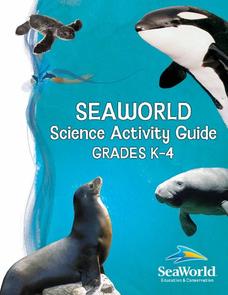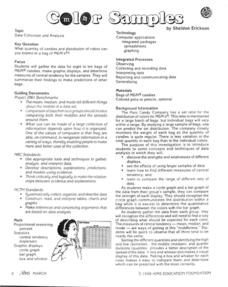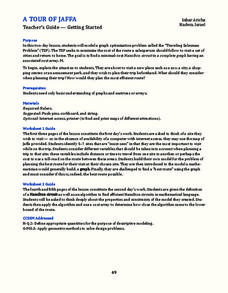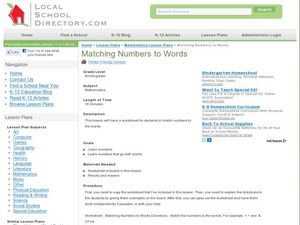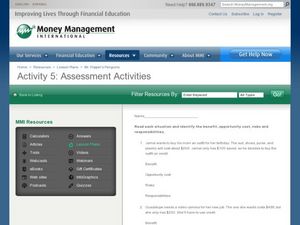EngageNY
Fundamental Theorem of Similarity (FTS)
How do dilated line segments relate? Lead the class in an activity to determine the relationship between line segments and their dilated images. In the fourth section in a unit of 16, pupils discover the dilated line segments are...
EngageNY
The Computation of the Slope of a Non-Vertical Line
Determine the slope when the unit rate is difficult to see. The 17th part of a 33-part series presents a situation that calls for a method to calculate the slope for any two points. It provides examples when the slope is hard to...
EngageNY
Definition and Properties of Volume
Lead a discussion on the similarities between the properties of area and the properties of volume. Using upper and lower approximations, pupils arrive at the formula for the volume of a general cylinder.
EngageNY
Informal Proof of AA Criterion for Similarity
What does it take to show two triangles are similar? The 11th segment in a series of 16 introduces the AA Criterion for Similarity. A discussion provides an informal proof of the theorem. Exercises and problems require scholars to apply...
EngageNY
Designing a Search Robot to Find a Beacon
Build right angles using coordinate geometry! Pupils explore the concept of slope related to perpendicular lines by examining 90-degree rotations of right triangles. Learners determine the slope of the hypotenuse becomes the opposite...
Beyond Benign
Ecological Footprint
How does your lifestyle measure up in terms of your ecological footprint? Young ecologists examine their impact on the planet using an insightful online calculator. A short quiz asks users to rank the size of their homes, their energy...
Sea World
Seaworld Science Activity
A fun collection of activities about marine life would be a great addition to your elementary science unit. From cute penguins to scary sharks, the unit features crafts, experiments, and basic research projects that will teach your...
It's About Time
How Do Carbon Dioxide Concentrations in the Atmosphere Affect Global Climate?
Does carbon dioxide really affect temperatures across the world? This fifth installment in a six-part series investigates the relationship between carbon dioxide and global temperatures. Graphs created from genuine data help young...
Curated OER
Missing Addends
In this early childhood math practice learning exercise, students use their problem solving skills to solve 6 story problems that require them to add.
Curated OER
Colors Samples
In this math worksheet, students take the time to count out the colors of the candies. They graph the results and make inferences from the information.
Curated OER
Expressions of Appalachian Mountain Folk
In this math worksheet, learners plot the coordinates and then unscramble a code in order to decipher a riddle about the expressions used in the Appalachian Mountains.
Beyond Benign
Plastic Bags
Paper or plastic? Explore the environmental effects of using plastic bags through mathematics. Learners manipulate worldwide data on plastic bag consumption to draw conclusions.
Fluence Learning
Writing a Narrative: Two Frogs
Three options offer young writers the opportunity to read a short story, answer questions, and write a response. A handy language arts resource focuses on reading comprehension and analyziing the story's lesson: look before you leap.
Beyond Benign
Packed Up Properties
Determine physical properties of potential packaging materials. Continuing from previous lessons in the series, the resource asks groups to identify physical properties of the substances. They test for conductivity, solubility, water...
Egmont
H.O.R.S.E.
Extend your lesson on Christopher Myers' H.O.R.S.E with a series of activities about basketball. After kids read the book, they match basketball terms with their definitions, find as many words as they can with the letters H, O, R, S,...
Curated OER
Banking Basics
Students examine ways to make money grow through banking basics. In this banking basics lesson, students identify the types of bank accounts and explore the different types of accounts. Students work in pairs to create pamphlets about...
Curated OER
Melissa's Garden
In this math activity, students identify the location of pictures on a coordinate plane. They write some answers as an ordered pair. They read ordered pairs and identify the picture at a specified location. Six problems are on a page. An...
Curated OER
A Tour of Jaffa
Use the age-old Traveling Salesman Problem to introduce Hamilton circuits to your young travelers. Individuals then plan an efficient route to visit all the places they want to go.
Kentucky Department of Education
Multi-Digit Multiplication Strategies
There is more than one way to solve a multiplication problem, and many learners find that the lattice multiplication method can be a helpful one. Fourth graders take an initial formative assessment before working in groups of two or...
Curated OER
Gerund Phrase Recognition Practice
In this gerund phrases practice worksheet, students discover what gerunds are as they read an informative lesson. Students then respond to 10 questions that require them to identify gerund phrases and identify the types of nouns they act...
Curated OER
Matching Numbers to Words
Students explore a math concept. In this math lesson, students practice matching a number with its corresponding word. Students can work independently or with teacher help.
Curated OER
Money situations
In this money situations worksheet, students read money word problems and then list the benefit, opportunity cost, risks, and responsibilities for each one. Students do this for 6 questions.
Fluence Learning
Writing About Informational Text: Music and the Brain
Even if you've never picked up a musical instrument, chances are that music has directly impacted your mental and emotional development. Sixth graders engage in a reading activity in which they read two articles on the impact of music on...
Curated OER
Addition and Subtraction
In this addition and subtraction worksheet, learners analyze a math sentence such as: 16+2 = 12-6. Students solve the problems on each side of the equal sign, and mark "true" if the answers are the same and "false" if they are different....








